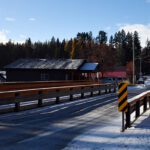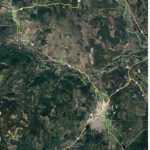Home »

A newbie spelunker ventures into Libuton Cave

When they said they were going to “take me to the caves,” my immediate reaction was “cool. Should make for some interesting photo opportunities.”
I visualized a crushed gravel path leading from a small ticket booth to either a continuation of the path into the side of a hill or set of stairs or an

elevator that led down to the start of a self-guided tour, complete with yellowing plastic-covered interpretive paneling explaining the difference between stalactite and stalagmites, different geologic periods and where one can purchase a postcard or trinket bearing the name  of the cave.
of the cave.
I’ve been to caves in the United Kingdom and United States, and expected a similar experience.
The opportunity to visit the Libuton Caves in Zamboanga del Norte, The Philippines, last year came about because my partner Carrie is working with the LGSP-LED, an eight-year collaborative program of the Governments of the Philippines and Canada, through the Department of the  Interior and Local Government (DILG) and the Canadian International Development Agency (CIDA).
Interior and Local Government (DILG) and the Canadian International Development Agency (CIDA).
“LGSP-LED envisions vibrant, investor-friendly and tourist-attractive local economies, and is geared towards strengthening the enabling  environment for good governance and sustainable local economic development,” its website describes.
environment for good governance and sustainable local economic development,” its website describes.
Part of our 2011 trip to the Philippines included site visits in Luzon, Zamboanga, Bohol and Cebu.
Prior to leaving, my research showed that

Zamboanga was the most dangerous place in the world, in 2010, for journalists, thanks to one large bomb that killed 60 in one fell swoop.

When we arrived in Dipolog, we were received as VIP guests and visited the governor’s offices before being taken to a Korean Restaurant for lunch.
While Carrie was to conduct her work, which is through the Association of Canadian Community Colleges, I was going to be ‘taken to the caves.’
Half way through lunch I was told my ride had arrived and, with just my trusty and spanking new Pentax, I went outside to meet my guides.
I was greeted by the head guide, Renan Agustin, a friendly but serious man of about 35. Standing behind him was a machine gun toting Philippine  soldier, three or four Philippine Red Cross workers and a couple of assistant guides.
soldier, three or four Philippine Red Cross workers and a couple of assistant guides.
It still hadn’t dawned on me what I may be in for. I wondered if there would be something to eat somewhere near the caves as I had not eaten much. Fact is, the day before I suffered through the worst bout of food poisoning (later turned out to be a stomach virus of some kind) of my life and hadn’t eaten much.
I clambered into a packed van and Renan began to instruct those gathered about how one should conduct him/herself while in the caves. We made  our way about 40 km south down the Zamboanga Peninsula to the municipality of Manukan, and once there we changed from the van to a beaten up four-wheel drive.
our way about 40 km south down the Zamboanga Peninsula to the municipality of Manukan, and once there we changed from the van to a beaten up four-wheel drive.
We turned off the main highway and headed up into the mountains, passing by tiny hamlets, where wood smoke drifted from thatched huts and curious residents waved at us or eyed us as we bounced past. It was about seven km of uphill driving, down a road that would make the average B.C. Forest Service Road seem positively highway-like. More surprising was the fact that a great many people lived along this road, only passable by four-wheel drive, dirt bike, foot of bicycle.
the average B.C. Forest Service Road seem positively highway-like. More surprising was the fact that a great many people lived along this road, only passable by four-wheel drive, dirt bike, foot of bicycle.
 We stopped at a small hamlet (Libuton) and alit from the jeep. Renan led us to a small building and we entered. Once inside, he clambered into a light blue set of overalls and joked about keeping his clothes clean and wife happy. The others in the party, aside from myself and the stoic soldier, also climbed into coveralls, adjusted helmets with lights, slipped on knee pads and prepared for what I was beginning to realize was a bit more than a saunter through a tourist
We stopped at a small hamlet (Libuton) and alit from the jeep. Renan led us to a small building and we entered. Once inside, he clambered into a light blue set of overalls and joked about keeping his clothes clean and wife happy. The others in the party, aside from myself and the stoic soldier, also climbed into coveralls, adjusted helmets with lights, slipped on knee pads and prepared for what I was beginning to realize was a bit more than a saunter through a tourist  cave.
cave.
Renan handed me a helmet and surveyed my hiking boots with some agreement and smiled. He led us out into the humid mid-day sun and single file we moved off the road and down a jungle path. Five or six steps down the path, Renan suggested I watch my footing as the mud was extremely slippery. He was just finishing his warning when ‘SLAP’ I slammed shoulder first onto the ground. He seemed worried. What  kind of fool was he guiding, I am sure he wondered.
kind of fool was he guiding, I am sure he wondered.
We hiked for about a mile through the jungle and Renan imparted his vast knowledge of the area, the montane jungle and the nearing caves. We passed through a natural coconut grove and he warned me to keep alert as one doesn’t wish to get beaned by a falling coconut. He told a story about passing through the area during a windy day and dozens of coconuts were falling. As the path cuts across a 30-40 degree slope, he  described how coconuts would bounce downhill like out-of-control bowling bowls.
described how coconuts would bounce downhill like out-of-control bowling bowls.
Once I had worked up a proper jungle-hile-lather, I was beginning to come to the firm understanding that I wasn’t going for a stroll. I was actually going spelunking.
I am not claustrophobic nor easily frightened by the unknown. However, after once venturing too far into a seaside cave in Cornwall, England, and became momentarily stuck facing into complete darkness without anyone knowing where I was, the notion of becoming a spelunker left me for good. Besides, big spiders scare the living hell out of me.
Suddenly, Renan and his two key guides stopped and they began fiddling with rope. I looked around me, searching for signs of a cave. I was standing about six feet from the entry and had no idea.
 Once some vegetation was gently parted, a hole about the size of Smart Car opened before us.
Once some vegetation was gently parted, a hole about the size of Smart Car opened before us.
An agile guide made his way down into the darkness – a spider-hole, I called it to myself with a frightened gulp. Then another guide entered and a couple of the Red Cross workers, before Renan guided me to the rope and instructed me on making my way down into the cave.
I managed to grapple my way down into the cave and one of the guides  placed his hand on my chest and told me to stand still. Renan slid down into the cave and began his vital work – making sure everyone, his guides included, made it through the cave without incident.
placed his hand on my chest and told me to stand still. Renan slid down into the cave and began his vital work – making sure everyone, his guides included, made it through the cave without incident.
The first thing he instructed us about was our footing. When one is walking through a cave, one must place their foot down and make sure it’s well placed and secure before they take another step. It’s like walking on squishy ice; incredibly slippery.
The cave system at Libuton, which includes at least three caves, has been well explored but many chambers remain a mystery. A National Geographic team even explored the caves with Renan and company a year before, doing an extensive shoot. I was just the latest visitor with a camera. (More on the possible future of Libuton at the end)
 Simply put, the wrong step could lead to death and disaster.
Simply put, the wrong step could lead to death and disaster.
Not long after we entered the first cave, Renan pointed at a spider on a wall. I amazed myself by leaning close, my headlamp joining Renan’s to illuminate it. I took a photo and leaned back. “That’s a male,” he said. “Harmless.”
Still, as I walked away, my hands moving along the walls to provide extra security, I began to freak out about the possibility of my hand sliding over such a creature. The spider was about two-thirds of the size of my hand.
Once the shiver about arachnids began to wane, I soaked in Renan’s enthusiasm for the caves he so obviously loves.
 He spoke about the vision for the caves is to turn them into a tourism venue – but a natural one. Renan talked about how the caves have been sullied over the years by people looking for black pearls, found naturally in the caves. However, increased awareness and attendance at the caves had cut down on those instances. The presence of the soldier began to make some sense to me.
He spoke about the vision for the caves is to turn them into a tourism venue – but a natural one. Renan talked about how the caves have been sullied over the years by people looking for black pearls, found naturally in the caves. However, increased awareness and attendance at the caves had cut down on those instances. The presence of the soldier began to make some sense to me.
Renan pointed out bats and spoke about the guano. “Do you smell that?” He asked at one point. I did smell it. It smelled like someone in our party had sparked a joint. Turns out that was the guano. We were standing in several inches of the stuff.
asked at one point. I did smell it. It smelled like someone in our party had sparked a joint. Turns out that was the guano. We were standing in several inches of the stuff.
Along we wandered, our lights catching on an endless array of shapes and figures, with ancient stalactites reaching down to try and join stalagmites, both created from limestone being dissolved by water. The potential age of some, connected from centuries of dissolving and process, left me boggling. They were ten to 15 feet in length. Considering a stalactite (top) and stalagmite (bottom) grows by on average .037 inches or .929 millimetres a year, you start to get a clear picture of  time’s relentless and achingly slow march when it comes to geomorphic creation.
time’s relentless and achingly slow march when it comes to geomorphic creation.
Renan made sure we didn’t touch the cave’s delicate features whenever possible, noting that oils from human skin can stain them, altering them forever. He even showed evidence of such contact.
Near the end of the first cave, we came into a vast chamber, with several openings about 30 or more feet above our heads. The jungle cascaded down into the cave, along with sunlight.
We emerged from the cave into that bright sunlight and Renan spoke about how the Libuton Caves are different to from other spelunking locales because they are “one way”  adventures, meaning one enters at one side of the cave and leaves from another. The first cave took about 45 minutes to pass through and I cannot tell you how long it was, as we moved in short, careful bursts, between stops where Renan spoke about the ecosystem and environment around us.
adventures, meaning one enters at one side of the cave and leaves from another. The first cave took about 45 minutes to pass through and I cannot tell you how long it was, as we moved in short, careful bursts, between stops where Renan spoke about the ecosystem and environment around us.
A short hike through more montane jungle brought us to the second cave. I noticed before we entered that our soldier was leaving. An hour later I knew why.
This cave seemed much like the first one, though Renan appeared a bit more serious. It turned out this cave feature a few more opportunities for peril for those venturing within.
At one point we came to a narrow wall, with a pitch black hole yawing downward. Renan carefully placed his hands against one wall, and wedged his boots against a narrow ledge and he sidled for about a dozen or more feet. “Okay, now you do exactly what I did,” he said.
 I placed my hands against the wet wall and boots onto the ledge, which was about six inches wide and mimicked the guide. Once I stepped onto the opposite landing, Renan chirped, “Well done. I’ve had people get half way across stop and start to cry.”
I placed my hands against the wet wall and boots onto the ledge, which was about six inches wide and mimicked the guide. Once I stepped onto the opposite landing, Renan chirped, “Well done. I’ve had people get half way across stop and start to cry.”
I asked how far down it was – into that black yawning abyss and my guide admitted he had no idea.
A short time forward, Renan pointed out a giant centipede (about a foot long), and he also pointed out other cave life, including crickets and fresh water shrimp. Then he pointed at another spider.

“Female. Pregnant. Don’t go hear her they’re really aggressive when they’re pregnant. And poisonous.”
Arachnid terror began to crawl up my spine again. I took a photo of the pregnant female but my heart was racing so fast the image was out of focus – even with autofocus.
Wading through water was normal in both caves, but the egress of the second one involved one  having to really get down and dirty.
having to really get down and dirty.
After wading crotch-deep in cool water, we came to a point where the ceiling dropped down and the only way forward was to get down on your belly and squirm through thick, slimy mud. Renan took my camera (which was in a small bag) so I could wriggle forward, trying not to grab small stalactites that jabbed at our helmets and backs, to pull myself forward. After about 20 or so feet, light poured in and the ceiling rose and there was the exit.
Directly below the exit was a lovely fresh water stream, which my guides and the Red Cross workers trotted to and began bathing in. I followed suit and reveled in the cool, fresh invigoration. The soldier met us at the creek. He would have had a difficult time moving his gun through that challenge.
 Renan spoke of a third cave, which was back near Libuton village. I was ecstatic to be back out in the sunshine and, admittedly, I was completely exhausted. By the time we walked the three or so kilometers back to the village, including a saunter through a primitive jungle village, complete with half naked children staring at us with complete amazement, I was done. Spent.
Renan spoke of a third cave, which was back near Libuton village. I was ecstatic to be back out in the sunshine and, admittedly, I was completely exhausted. By the time we walked the three or so kilometers back to the village, including a saunter through a primitive jungle village, complete with half naked children staring at us with complete amazement, I was done. Spent.
As we clambered out of our wet and dirty gear, villagers hacked at green coconuts and handed them to us with straws. The sweet, thick juice provided immediate energy. Then one of the guides handed out hamburgers, likely from somewhere in Manukan. I couldn’t eat mine. The  combination of exhaustion, previous lack of nourishment from a savage stomach bug and the sweet power of the coconut put me into a mild stupor. I couldn’t imagine venturing into a third cave.
combination of exhaustion, previous lack of nourishment from a savage stomach bug and the sweet power of the coconut put me into a mild stupor. I couldn’t imagine venturing into a third cave.
While we prepared to leave, Renan pointed out the rough area where the caves were located and described how he’d love to see a small campground with some basic amenities for spelunkers to enjoy. His caves could be a small boon to an area that desperately needs increased economic  opportunities.
opportunities.
My adventure in the Zamboango backcountry and Libuton Cave included a bounce up another mountain road and across a shallow river to a cassava plantation, hidden deep in the jungle. And the ride back to Dipolog was in a packed four-wheel-drive, with its windows completely fogged from the torrential rainfall. The driver, using a small cloth, kept wiping at a small square in his windshield so he could see. It took about 90 minutes to drive perhaps 40 km.
I parted ways with Renan and thanked him for what was easily one of the more surprise adventures of my life.
I left knowing this man’s firm conviction and love for his caves and region and I hope to one day return to see the proposed ecotourism site being developed and promoted by the Dipolog-Dapitan-Polanco-Katipunan-Roxas-Manukan (DDPKaRoMa) Alliance.
 Carrie is currently once again in the Philippines, working in Greater Manila and Cebu. She was supposed to return to Zamboanga and Mindanao, but insurance issues and a warning from the Canadian government nullified that option.
Carrie is currently once again in the Philippines, working in Greater Manila and Cebu. She was supposed to return to Zamboanga and Mindanao, but insurance issues and a warning from the Canadian government nullified that option.
Everywhere we went in the two days we were there last year, we were accompanied by three soldiers. We were guests of the governor and a police/military presence was protocol, we were told by the governor’s aide. The soldiers kept vigilance over us during our night in Dapitan, an historic city just up the coast from Dipolog where the Philippines’ national hero, Dr. Jose Rizal, hid out from Spanish oppressors before helping lead his people to independence.
Two of Rizal’s novels “stirred the conscience of his people” and resulted in his execution, but his works served their purpose and his death fired up Filipinos enough to have them fight for independence.
The Philippines is a fascinating nation made up of more than 7,100 islands. Located in the southern edges of this archipelago, the Zamboanga/Mindanao area features idyllic island beauty surrounded by sweeping poverty and much strife, to the point that it is considered the most dangerous place in the Ring of Fire nation.
Attempts at economic diversification will be hampered by ongoing internal strife, but the work being done by LGSP-LED is providing support for consensus building workshops, community mobilization, and training for cave guides and masseuse/masseurs, as well as the provision of signages at Manukan and Libuton.
“A mapping of possible resources led to the Alliance’s further mobilizing of support from other partners: the Department of Environment and Natural Resources (DENR) on cave protection; the Red Cross on disaster management, the Technical Education and Skills Development Authority (TESDA) and the Department of Trade and Industry (DTI) on entrepreneurship and basic bookkeeping, Department of Labor and Employment (DOLE) for the provision of massage kits, and the Dipolog Outdoor Society on cave exploration and guiding,” notes the DDPKaRoMa website. “The Alliance has adopted a local economic development strategy built on opportunities for agri-industry from high value crops, mango and cassava, as well eco-cultural tourism.”
I wish them all the best in their efforts and thank them, from the bottom of my heart, especially Renan Agustin and his guides, for an amazing adventure. May your good work continue. Until next time.
Ian Cobb/e-KNOW








